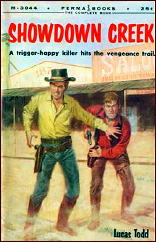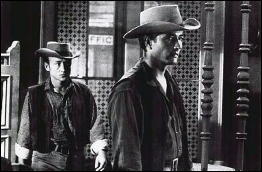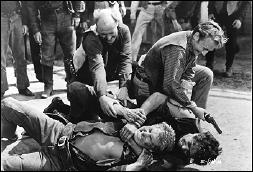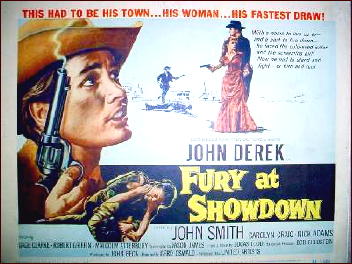Tue 2 Oct 2012
A Western Book! Movie!! Review by Dan Stumpf: SHOWDOWN CREEK / FURY AT SHOWDOWN (1957).
Posted by Steve under Reviews , Western Fiction , Western movies[22] Comments
LUCAS TODD – Showdown Creek. Macmillan, hardcover, 1955. Toronto Star Weekly Novel, newspaper supplement, Saturday 19 November 1955. Permabook M-3044, paperback, 1956
FURY AT SHOWDOWN. United Artists, 1957. John Derek, John Smith, Carolyn Craig, Nick Adams, Gage Clarke, Robert Griffin. Screenplay: Jason James, based on the novel Showdown Creek, by Lucas Todd. Director: Gerd Oswald.

Showdown Creek is the kind of spare, gritty tale that Westerns should aspire to. Researching this, I can find no other book attributed to Lucas Todd, the author, nor any bio/bibliographic background on him, but perhaps that’s as it should be for a book that celebrates the outcast as this once does.
As the story opens, Brock Mitchell is trying to ramrod a one-horse ranch for his broken-legged Uncle Ben and live down a reputation as a smart-ass hellion. Uncle Ben has arranged financing to get him through lean times, but the deal’s hit a snag, and nobody seems to know what the delay is —- until Mitchell learns that Chad Deasey, an ex-con with a grudge against him, has hit town and put up a respectable front, tied in with the most prominent local lawyer (soon to turn up dead) and persuaded the town banker to put the brakes on Uncle Ben’s deal, apparently just to ruin him and repay Mitchell for killing Deasey’s brother in a fair fight back in Brock’s gun-toting days.
It’s pretty standard stuff for a Western: crooked banker, shady lawyer, upright hero handy with a gun, honest ranchers and even a purty blue-eyed widder woman trying to understand it all. Author Todd seems to know something about moving cattle around (not all western writers do) and he puts it across as he ladles out the more standard ingredients into his prairie stew, giving Peters a hot-headed sidekick and adding something about the railroad coming through.

But he also tinges all this with an almost intangible feel for the dilemma of a flawed man painfully misunderstood. Every fight, shoot-out and unsolved crime echoes not only in physical violence but also in the looks Brock gets from the good citizens of Showdown Creek: the rumors, conversations broken off when he enters a room, and his increasing isolation from a community he needs.
It’s intriguing stuff, and if it never quite rises to the level of Camus, the sense of alienation is still strong enough to lift this above the run-of-the-range shoot-’em-down and linger in the memory.
Showdown Creek was filmed, appropriately enough, by Gerd Oswald, himself something of a Hollywood pariah, who was given only five days and a cast of unknowns and no-talents to do the job —- the only two players you ever heard of in this movie are John Derek and Nick Adams, so you see what I mean about the acting.

The marvel is that Fury at Showdown emerges as a tight, deeply-felt tale of guns, cattle and youthful angst.
Given the low budget and tight schedule, Fury at Showdown is necessarily a town-bound western, rarely leaving the claustrophobic confines of office, saloon and jail for the free range that now seems more like a false promise than the reality of the West.
Somehow, though, that only helps convey the sense of constriction felt by the hero (or supposedly felt; this is John Derek acting, remember) as he struggles to reach some wide open plain of the soul, free of the town’s censure.
That sounds like tall boots for a B Western to fill, but writer Jason James tweaks the story significantly — in his version, Chad Deasey has always been a respectable citizen and it’s Brock Mitchell who’s the ex-con, just released from jail for killing Deasey’s brother — and director Gerd Oswald puts it across with well-judged camera work and a sense of pace that never falters.
Fury at Showdown never got much attention, and it’s far from ideal, but definitely worth your time.

October 2nd, 2012 at 10:30 am
It’s hardly fair to lump John Smith in with the “unknowns and no-talents.” Like Nick Adams, he was a charismatic and successful TV star (four seasons as one of the two leads on Laramie).
October 2nd, 2012 at 12:04 pm
I don’t think you can say no-talent and come out with something acceptable in five days. In fact, the opposite is probably the case.
October 2nd, 2012 at 12:06 pm
Point well taken, Joseph. Besides his long stint on LARAMIE, John Smith was also the co-star of CIMARRON CITY for its one and only season (with George Montgomery and Audrey Totter).
Strangely enough, his name at birth was Robert Errol Van Orden. Says IMDB: “His agent Henry Willson, who also gave Tab Hunter and Rock Hudson their names, changed Van Orden’s name to ‘John Smith’. […] According to his obituary, Robert Van Orden changed his name to John Smith in order to be ‘the only one in the business.'”
I confuse him with actor William Smith, but that’s only me.
October 2nd, 2012 at 12:17 pm
Barry
It sounds to me that director Gerd Oswald deserves a lot of credit for making this movie what it is, including getting some good performances from the cast. I’ve not seen it, but here’s a long excerpt from the review it got in the NY TIMES:
“[…] a surprisingly decent little Western titled ‘Fury at Showdown.’
“John Derek, the small cast’s only ‘name,’ is starred in this United Artist’s release, a Robert Goldstein presentation. After about ten minutes, it becomes obvious that some leathery citizens of a place called Showdown Creek are sounding and behaving like real people.
“Why? Because this unpretentious, low-budget entry is leanly written, tersely acted and, above all, straightforward. […]
“It is nice indeed to watch the unapologetic way in which the camera clings to the dusty main street where most of the action unfolds. Under Gerd Oswald’s sure direction, this tightly authentic atmosphere, the good, blunt dialogue and some discreetly inserted music do much to project the urgency of Mr. Derek’s plight—that of a young man at his life’s crossroads.
“Add to this a strictly sideline romance, one humdinger of a fistfight and a climax centering on the foreclosure of a bank note, no less. Best of all, perhaps, from a low budget come some interesting suggestions about courage, self-deception and trial by evidence.
“Mr. Derek fits his part to a T. Nick Adams is quietly effective as his loyal brother, and so is Carolyn Craig, as the hero’s old flame. As the culprit, Gage Clarke is a convincing, wide-eyed sadist….”
October 2nd, 2012 at 12:23 pm
Sure Steve. No problem at all. But, Dan wrote a cast of no-talents. Cannot be the case. In fact, must have been a group that was able behind the camera and in post-production as well.
October 2nd, 2012 at 1:49 pm
Barry,
What I wrote was “a cast of unknowns and no-talents’ which is hardly the same as “a cast of no-talents.”
And I apologize to the legions of John Smith fans out there for calling him “unknown.”
October 2nd, 2012 at 2:34 pm
Dan,
You are very cute.
All I really intended to say was, if the product or result is satisfactory, no-talent is a misnomer. And, I don’t believe they were so unknown.
The film theorists like to give credit to director’s as principal authors. Usually, not me. In this case, it is probably more true than in most.
October 2nd, 2012 at 5:42 pm
Getting back to the author, Lucas Todd, I haven’t been able to find anything more about him either, which is unusual. Most authors can’t seem to escape being noticed by Google somehow or another.
It may be that Lucas Todd is a pen name — it sounds as though it might be — but if so, whose?
October 2nd, 2012 at 6:56 pm
Found him at Stanford University Copyright Renewal page.
Showdown Creek
Lucas Todd pseud of Stanley Kauffmann.
Other books listed under Stanley Kauffmann:
Man of the World
A Change of Climate
The Tightrope
The Hidden Hero
This Time Forever; a romance (first serialized in Woman’s Home Companion June-Aug 1944
Now, is this Stanley the same one who contributes to The New Republic and reviewed movies and theatre since 1958?
October 3rd, 2012 at 10:16 am
Great work, Michael. There may be more than one Stanley Kauffmann, but I have discovered that the author SK of MAN OF THE WORLD is the same as Stanley Kauffmann the film critic:
http://www.scribd.com/doc/80367126/Regarding-Film-Criticism-and-Comment-PAJ-Books (You may have to scroll down.)
Can we connect up the Lucas Todd SK with the SK who wrote MAN OF THE WORLD?
http://books.google.com/books?id=QRohAQAAIAAJ&pg=PA1437&lpg=PA1437&dq=Stanley+Kauffmann+Lucas+Todd&source=bl&ots=ihhxfkxMmi&sig=6NPBV8zEfjp0I4v6hjrOqdL5IKg&hl=en&sa=X&ei=4FVsUPmUGoWwqAHxjIGQCA&ved=0CCUQ6AEwAQ#v=onepage&q=Stanley%20Kauffmann%20Lucas%20Todd&f=false
I won’t have time to follow up on this myself until later today.
October 3rd, 2012 at 11:12 am
#10. Yes, according to who owns the copyright of both.
October 3rd, 2012 at 4:55 pm
This page of copyright entries seems to clinch it
http://www.copyrightencyclopedia.com/%5Bthe-devils-of-kawalerowicz-and-other-contributions%5D-by/.
So there we have it. Stanley Kauffmann the film critic was the author SHOWDOWN CREEK. Fine work on your part!
October 4th, 2012 at 3:13 am
Mike, I’m really impressed.
October 4th, 2012 at 8:32 pm
Not to mention in Fury, the best fight seen I’ve ever seen, bar none. Whenever they play it on tv, I make sure I watch it AGAIN, at least through the fight scene.
October 4th, 2012 at 9:28 pm
No-names and no-talent??? Excuse me? If the actors had no talent, there would be NO WAY they could have turned Fury at Showdown out in 5 days – let alone produce a film that was quite watchable. Nick Adams was known and John Smith was a budding star. By the time this film was made John Smith had been in no less than 13 movies – standing toe to toe with the likes of John Wayne, Joel McCrea, Humphrey Bogart, Aldo Ray, Debbie Reynolds, Bing Crosby and a host of others GREAT stars. He certainly was no BEGINNER in the business and in my humble opinion, he was the best actor in the entire movie – no overacting – but an understated badguy with a vicious grin and a nasty temper – not to mention how danged handsome he was!! And yes, the fight scene is REMARKABLE for it’s time!
Mary
October 5th, 2012 at 3:03 am
Looking back, I think in my effort to emphasize Oswald’s meager resources in making this film, I may have slighted some of the thespians involved. Though neither were “name” actors at the time, John Smith is indeed quite good as the dog-heavy (he certainly acts John Derek off the screen) and Gage Clark is very watchable as the dress-heavy. And hell, for all I know, John Derek and Nick Adams were trying to coney a certain stone-faced uncertainty in their characters.
November 19th, 2012 at 1:07 pm
I love this film. Even if we don’t cut everyone some slack for the week’s shoot, I the acting seems very good, particularly Derek and Adams.
Pa, you’re right, that’s a great fight.
Thanks to everyone for sorting out the author.
August 21st, 2013 at 10:09 am
Follow the link below for lots of information about Stanley Kauffmann, including a reference to SHOWDOWN CREEK and this blog:
http://bookpublishinginstitute.org/2013/08/21/the-mystery-of-terry-kirk/
April 16th, 2016 at 4:20 pm
Very nice! I had finally decided to put some effort into working out the identity of the Western that Kauffmann mentions, in his memoirs, as having written pseudonymously in the summer of 1954. To that end, I just spent a half-hour browsing IMDB for the credits of every Western film produced in 1956-1958 in hopes of working backwards to what Kauffmann describes as “Shootout Canyon” by “Terry Kirk”. Having just settled on Todd’s “Showdown Creek” as the likeliest candidate, I see that I was years too late in my search!
By the way, Kauffmann reports that the pseudonym was the name of a minor character in one of his earlier novels.
Kauffmann uses pseudonyms for many other names and titles in the early chapters of his 2007 memoirs, which had been published separately 27 years before. Another such mystery for me was the Broadway play that he calls “Heritage of Glory”, which he script-doctored and took over without credit as director. (It flopped anyway.) The nominal director he calls “Michael Brimmer”, better known as a film director, and he reports that at the end of the fiasco, he loaned Brimmer $110, which was never paid back.
The Internet Broadway Database has no listing for Kauffmann. A key clue for me is that in Kauffmann’s short 1993 review in “The New Republic” of “Matinee”, a film in which John Goodman plays a character inspired by William Castle, Kauffmann says that Castle died owing him $110. According to IBDB, Castle directed just two plays on the Great White Way, in 1944 and 1945, and the latter was “Star-Spangled Family”, which closed after just four days.
August 31st, 2016 at 12:33 am
Just saw this western was good in spots but nothing that special. I give 5 out of 10. I just noticed that the girl, played by Carolyn Craig, died by self inflicted gunshot in 1970. She was only 36.
December 12th, 2016 at 6:52 pm
The following titles are further two novels by Stanley Kauffmann:
A New Desire, Popular Library N° 705/1955
The Philanderer, Popular Library SP-30/1958
December 12th, 2016 at 7:25 pm
Thanks, Tiziano!